The Abstract-expressionist painter Joan Mitchell is an American artist whose large canvases of the fifties still touch me even now. ‘Touch’ is the right word because her paintings are very physical in their presence, and her mark-making core-deep, both physically and emotionally.
If there was a great Excel sheet of artists organized by styles, I would personally not be in Joan Mitchell’s column. But on a more fundamental level of art-making I am deeply influenced by her work, particularly by their stand-alone beauty, canvas by canvas. I feel the beauty in her work to be a reflection of the raw courage with which she uses, like Pollack or DeKooning, the very act of painting itself to speak directly from her visceral center. She makes me so aware of where I hold back, and at the same time inspires me to be responsible for my own suppressed energy—and not only as an artist, but equally as a person.
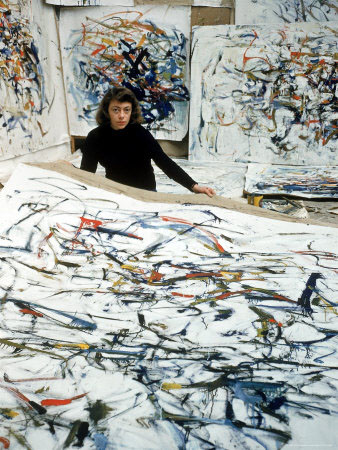
Joan Mitchell was born into the post-war explosion of a new American art after Pollock. Before the age of 30 she had met painters like Kline, Motherwell and DeKooning, and presented her first one-person show in New York in 1957. She quickly became by every standard not only a well-respected painter in the Abstract Expressionist movement, but a keen student of the world, living most of her adult life both in New York and Paris. And alas, like many of her intensely urban, ambitious and aesthetically driven companions, was soon an alcoholic, a chain smoker and an ‘obsessive’, working long and isolated hours for which she paid a serious price later in life.
Nevertheless, driven by her intensity of focus and non-stop work ethic, Joan Mitchell early on produced a massive and potent number of very large canvases and drawings. Critical reactions were mixed. Those painters who treated the canvas as a physical event (like Jackson Pollock, Hans Hoffman et al) instantly responded to her new and major presence.
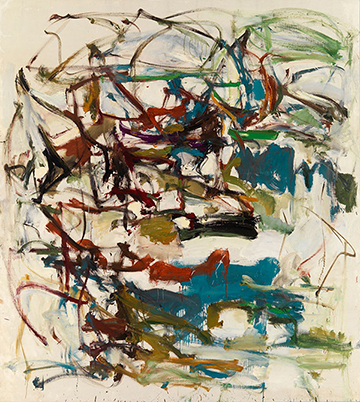
But among the more conservative art factions of the time, Mitchell’s works were often dismissed as angry expressions of personal frustration and especially annoying in the hands of a woman. Even among her own kind of painters, Joan Mitchell was a rare intrusion of a (yes, even small) woman into a dominantly male world of American action painting. That post-war intellectual art domain mirrored the hard-living art heroes of the twenties, like Hemingway and Scott Fitzgerald, and so was unprepared for a woman who matched them in scale and a furious energy, years before any women’s movement had appeared on the intellectual scene..
Certainly there were many elements of personal imbalance in Mitchell’s make-up. But as any good therapist knows, anger or frustration are just forms of suppressed energy which in the hands of a practiced painter like Joan Mitchell (or Vincent Van Gogh) could be and were eloquently transformed into her lyrical mirrors of energy as action itself, mark-made mirrors of human energy that are as memorable as any painter of her time, man or woman.
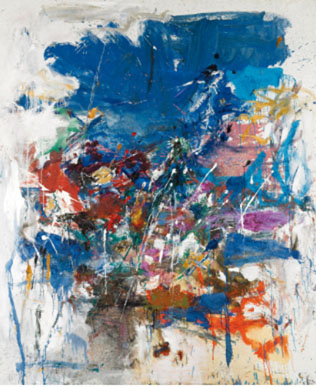
From my own long experience as an artist, I know that my own strength derives its foundation from looking for and allowing many artists to influence me, even across the boundaries of time, style, and temperament. I encourage my own students to both look widely for and acknowledge one’s mentors because that very search supports getting to know one’s deeper self. Let me mention a few more of my own ‘influencers’ besides Joan Mitchell as examples of what I mean by the word ‘influence’:
- Josef Albers I am not the same as an artist after the gentle voice of Albers introduced me to the inherently subjective nature of color as a silent and emotional presence to all of life (cf: in his transformative work, The Interaction of Color).
- Pablo Picasso My own habits of reticence, habits like ‘let’s think about it some more’ are challenged everyday by Picasso’s drawings, inspiring me to trust my deeper physical impulses when I make my moves.
- Fra Angelico The layers of several visions in a single work, as in his 15th Century fresco (The Annunciation in the monastery of San Marco in Florence) which includes the (1) emotional power of abstract pattern, but now co-joined to the (2) new intellectual wonder of spatial perspective, without letting go of (3) his religious ardor in the service of a canonical and universal narrative of birth.
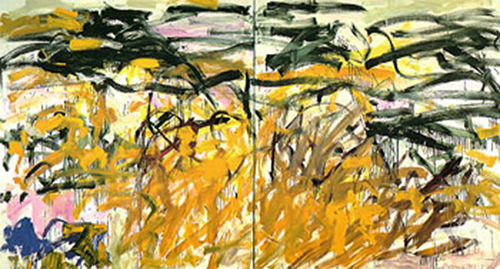
In most spiritual teachings, it is considered essential to acknowledge one’s teachers and lineage as a keystone to mastery and a barrier to any temptation to self-credit (hubris). I have discovered in my own art-practice that acknowledging those who have inspired me also reveals and expands the richness of my own opportunity as an artist of our time.

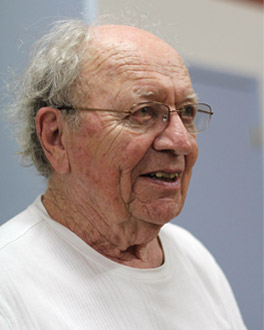


One Response to Joan Mitchell, Abstract Expressionist (1928-1992)